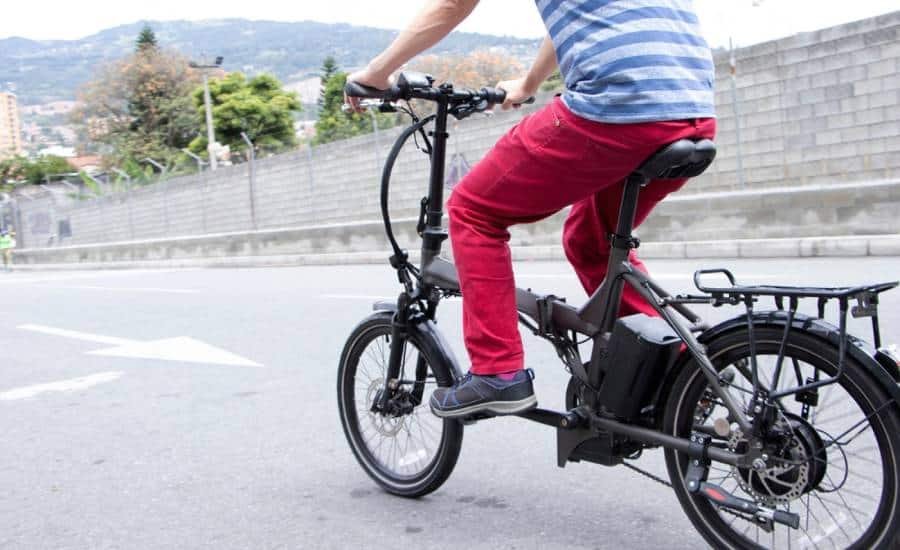Are electric bikes really the answer to a greener future? They certainly seem to be gaining popularity, with sales soaring in recent years. In fact, according to a report by Statista, the global market for e-bikes is expected to reach $62.3 billion by 2030.
But before you rush out to buy one, it’s important to consider the potential downsides. While e-bikes have many benefits, including reducing traffic congestion and improving air quality, they also have their drawbacks.
One of the most common problems is their limited range, with many models requiring frequent charging. In this post, we’ll explore some of the disadvantages of electric bikes and discuss why they matter for both consumers and the environment.
What is the Downside of Ebikes?

Now that we have established the growing popularity of electric bikes and why it’s important to consider the potential downsides, let’s take a closer look at some of the disadvantages of this mode of transportation.
Environmental Impact of Electric Bikes
While e-bikes offer many benefits, such as reduced commuting costs and increased accessibility, they also come with a few disadvantages, particularly in terms of their environmental impact.
One of the main environmental drawbacks of e-bikes is their reliance on batteries. E-bike batteries contain lithium, which is a non-renewable resource that requires significant energy to extract and process. Additionally, the manufacturing and disposal of lithium batteries can generate greenhouse gas emissions and other environmental pollutants, which can have a negative impact on the environment.
Another environmental concern related to e-bikes is the energy required to charge the batteries. While e-bikes are generally more efficient than traditional bikes, they still require energy to operate, which can contribute to greenhouse gas emissions if the energy comes from non-renewable sources like coal or natural gas. However, if the energy comes from renewable sources like wind or solar power, the environmental impact can be significantly reduced.
Additionally, the production and transportation of e-bikes can also have an environmental impact. Like traditional bikes, e-bikes are made from materials that require energy and resources to extract and process. Additionally, e-bikes are often manufactured in other countries and then shipped to their final destination, which can result in significant emissions from transportation.
Finally, e-bikes can contribute to increased traffic and congestion in urban areas, which can have a negative impact on air quality and the environment. While e-bikes are generally considered a greener mode of transportation than cars or buses, they still require space on the road and can contribute to traffic congestion.
In conclusion, while e-bikes offer many benefits, they also come with a few environmental drawbacks. To minimize the negative impact of e-bikes on the environment, it is important to choose energy-efficient models and use renewable energy sources to power them. Additionally, efforts should be made to recycle or properly dispose of e-bike batteries and reduce transportation emissions associated with their production and shipping.
Range and Battery Life Limitations

One of the main disadvantages of electric bikes is their range and battery life limitations.
Range refers to the distance that an electric bike can travel on a single charge, while battery life refers to the length of time that a battery can hold its charge. Most electric bikes on the market today have a range of between 20 to 50 miles per charge, which can vary depending on factors such as terrain, speed, rider weight, and weather conditions.
While this may be sufficient for many people’s daily commute or recreational rides, it may not be enough for longer trips or adventures. Riders who want to go on longer trips or travel greater distances may need to plan their routes carefully to ensure that they can reach a charging station or carry a spare battery.
Another issue with electric bike batteries is that they can degrade over time, resulting in reduced range and battery life. Lithium-ion batteries, which are commonly used in electric bikes, can lose up to 20% of their capacity per year, depending on usage and storage conditions. This means that riders may need to replace their batteries more frequently than they would like, which can be expensive.
In addition to these range and battery life limitations, electric bikes are also generally heavier than traditional bicycles due to the weight of the battery and motor. This can make them more difficult to maneuver and transport, especially for riders who need to carry them up stairs or on public transportation.
Maintenance and Repair Costs

One significant disadvantage of electric bikes is the maintenance and repair costs associated with their operation. E-bikes have a lot of electrical and mechanical components that require regular maintenance and repair. For instance, the battery, motor, and controller all need to be serviced periodically to ensure optimal performance.
These components are typically more expensive to replace than those on traditional bicycles, which means that maintenance and repair costs can add up quickly.
In addition to the cost, finding a qualified technician to repair an e-bike can also be challenging. E-bikes require specialized knowledge and tools that not all bike shops possess. It can be frustrating and time-consuming to find a technician who knows how to work on your e-bike, which can lead to longer downtimes and higher repair costs.
Another factor to consider is that e-bikes tend to have a shorter lifespan than traditional bicycles. The battery, in particular, has a limited lifespan and will eventually need to be replaced. Depending on the battery’s quality and usage, it may need to be replaced every two to five years. The cost of a new battery can be significant, and replacing it can be a complicated process.
Finally, the complexity of e-bikes makes them more prone to breakdowns and malfunctions. This means that riders may need to have their bikes repaired more frequently than they would with a traditional bike. As a result, e-bike owners may find themselves spending more money on maintenance and repairs over time.
In conclusion, while electric bikes offer many benefits, they also come with significant maintenance and repair costs. These costs can add up quickly and make e-bikes more expensive to own and maintain than traditional bicycles. As such, anyone considering purchasing an e-bike should factor in these costs before making their decision.
Safety Concerns

One significant safety concern with electric bikes is their speed. Unlike traditional bicycles, electric bikes can travel at higher speeds, and riders may not be adequately trained or experienced to handle these speeds. Additionally, the added weight and power of the electric motor may make it more challenging to handle the bike, particularly for those who are not used to riding bikes regularly.
Another safety concern with electric bikes is the potential for battery-related issues. Lithium-ion batteries, which power most electric bikes, have been known to overheat, catch fire, or explode. While these incidents are relatively rare, they can occur, and riders should take proper precautions to prevent such events.
Finally, electric bikes may be more prone to theft. The added cost and complexity of the electric motor and battery make them more attractive targets for thieves than traditional bikes. While it is possible to purchase locks and other anti-theft devices, riders must remain vigilant about their bike’s security to prevent theft.
In conclusion, electric bikes offer several benefits, but they also come with some disadvantages and safety concerns. Riders must be aware of these issues and take proper precautions to ensure their safety and the security of their bike. It is essential to follow all traffic laws, wear proper safety gear, and maintain the bike regularly to minimize these risks.
Expense of Purchasing an Electric Bike

One of the most significant disadvantages of electric bikes is their cost. Compared to traditional bicycles, electric bikes are generally more expensive due to the added components and technology required to power them. The expense of purchasing an electric bike can be a significant barrier for many people, especially those who are looking for an affordable mode of transportation or recreational activity.
The cost of an electric bike can vary widely depending on the brand, model, and features. In general, you can expect to pay anywhere from a few hundred dollars for a basic electric bike to several thousand dollars for a high-end model with advanced features and components. Additionally, the cost of maintaining and repairing an electric bike can also be higher than that of a traditional bike due to the more complex technology involved.
Another factor that contributes to the expense of purchasing an electric bike is the cost of the battery. Electric bike batteries are typically one of the most expensive components and may need to be replaced periodically. Depending on the size and type of battery, this cost can range from a few hundred to several thousand dollars.
Despite the initial cost, it’s important to note that electric bikes can actually save you money in the long run. They are an eco-friendly and efficient mode of transportation that can help you save on gas, parking fees, and other expenses associated with driving a car. Additionally, if you regularly use your electric bike instead of a car or public transportation, you may be able to recoup the cost of the bike over time.
In conclusion, the expense of purchasing an electric bike is one of the main disadvantages of this type of transportation. However, it’s important to consider the long-term benefits and savings that an electric bike can provide before making a decision.
Lack of Exercise Compared to Traditional Biking

Another disadvantage of electric bikes is that they can reduce the amount of exercise you get compared to riding a traditional bike. E-bikes provide an electric motor that assists riders in pedaling, making it easier to climb hills and travel long distances without getting as tired. As a result, riders may not need to pedal as much, which means they won’t be burning as many calories or getting as much cardiovascular exercise as they would on a traditional bike.
While e-bikes can still provide some exercise benefits, especially for people who are unable to ride traditional bikes due to health conditions or physical limitations, they may not be as effective at improving overall fitness levels as traditional bikes. Additionally, some studies have suggested that riders may become reliant on the electric motor and stop pedaling altogether, which could further reduce the amount of exercise they get.
In conclusion, while electric bikes offer many benefits, including convenience and accessibility, they may not provide the same level of exercise as traditional bikes. If you’re looking to improve your fitness level or get a good workout, a traditional bike may be a better option. However, if you’re looking for a convenient and easy way to get around town or commute to work, an electric bike may be the perfect choice. Ultimately, the decision between an e-bike and a traditional bike will depend on your personal preferences, needs, and goals.
Restrictions on Where Electric Bikes Can Be Ridden

In many areas, e-bikes are treated similarly to traditional bicycles and can be ridden on bike paths and on the road. However, some municipalities have restrictions on where e-bikes can be ridden. For example, e-bikes may be prohibited from riding on certain types of bike paths or trails, or on sidewalks in busy areas.
One of the reasons for these restrictions is safety concerns. E-bikes can reach speeds of up to 28 mph, which is much faster than traditional bikes. This increased speed can pose a danger to pedestrians and other cyclists in certain areas. Additionally, some e-bikes may be classified as mopeds or motor vehicles, which would make them subject to additional regulations.
Overall, while e-bikes have many benefits, they do come with some disadvantages. Restrictions on where they can be ridden is one of these drawbacks, but it is important to balance safety concerns with the need for sustainable transportation options.
Need for Specialized Knowledge to Maintain and Repair Electric Bikes

Unlike traditional bicycles, electric bikes come with complex electrical components that require specialized knowledge and skills to maintain and repair. For instance, the battery, motor, and electrical wiring system of an electric bike are sensitive and can be easily damaged if handled improperly. Therefore, electric bike owners need to have a good understanding of the electrical components and systems of their bikes to prevent damage and ensure optimal performance.
Furthermore, electric bikes are more expensive than traditional bikes, and the cost of repairs can be significant. For example, if an electric bike’s battery or motor fails, it may require a costly replacement that may not be covered by warranty. This means that electric bike owners need to be prepared to invest more money in their bikes and maintenance compared to traditional bike owners.
Moreover, finding specialized repair shops or mechanics for electric bikes may be challenging, especially in areas where they are not yet popular. This can make it difficult for electric bike owners to get their bikes repaired in case of breakdowns or malfunctions, which can be inconvenient and frustrating.
In summary, the need for specialized knowledge to maintain and repair electric bikes is a significant disadvantage associated with these types of bikes. Therefore, electric bike owners should be prepared to invest more time, money, and effort in maintaining and repairing their bikes to ensure optimal performance and longevity. They should also research and identify reliable repair shops or mechanics to avoid inconveniences and frustrations associated with breakdowns or malfunctions.
Is Ebike Worth Buying?

The decision to buy an electric bike depends on factors such as individual needs, budget, and lifestyle. E-bikes make cycling accessible to more people and are environmentally friendly.
They can be more expensive than traditional bicycles, but costs vary based on quality and features. Maintenance is required, but less expensive than maintaining a car. Personal circumstances dictate whether an e-bike is worth the investment, so weighing pros and cons is crucial.
FAQs
Do electric bikes have problems?
Like any form of transportation, electric bikes can have problems, such as battery issues, motor malfunctions, and electronic failures. However, proper maintenance and regular inspections can help prevent these problems and ensure the longevity of the bike.
Are electric bikes a fire hazard?
Electric bikes can be a fire hazard if they are not used, charged, or stored properly. Like any lithium-ion battery, if an electric bike’s battery is damaged, exposed to extreme heat, or overcharged, it can catch fire. It’s essential to follow the manufacturer’s instructions and safety guidelines to prevent any potential hazards.
Are electric bikes expensive to maintain?
Electric bikes are generally more expensive to maintain than traditional bikes. This is because they have complex electrical components and batteries that require periodic maintenance, as well as specialized parts that can be costly to replace.
What are the main disadvantages of electric bikes compared to traditional bikes?
The main disadvantages of electric bikes are their high cost, heavier weight, and reliance on battery power, which may limit range and require charging. They also require more maintenance and repairs than traditional bikes.

